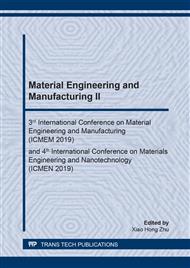[1]
Matthew J Allen, Vincent C Tung, and Richard B Kaner. Honeycomb carbon: a review of graphene. Chemical reviews, 110(1):132–145, (2009).
DOI: 10.1021/cr900070d
Google Scholar
[2]
KI Bolotin, KJ Sikes, J Hone, HL Stormer, and Ph Kim. Temperature-dependent transport in suspended graphene. Physical review letters, 101(9):096802, (2008).
DOI: 10.1103/physrevlett.101.096802
Google Scholar
[3]
Cory R Dean, Andrea F Young, Inanc Meric, Chris Lee, Lei Wang, S Sorgenfrei, K Watanabe, T Taniguchi, P Kim, KL Shepard, et al. Boron nitride substrates for high-quality graphene electronics. Nature nanotechnology, 5(10):722–726, (2010).
DOI: 10.1038/nnano.2010.172
Google Scholar
[4]
Xu Du, Ivan Skachko, Anthony Barker, and Eva Y Andrei. Approaching ballistic transport in suspended graphene. Nature nanotechnology, 3(8):491–495, (2008).
DOI: 10.1038/nnano.2008.199
Google Scholar
[5]
AC Ferrari, JC Meyer, V Scardaci, C Casiraghi, Michele Lazzeri, Francesco Mauri, S Piscanec, Da Jiang, KS Novoselov, S Roth, et al. Raman spectrum of graphene and graphene layers. Physical review letters, 97(18):187401, (2006).
DOI: 10.1103/physrevlett.97.187401
Google Scholar
[6]
Andrea C Ferrari and Denis M Basko. Raman spectroscopy as a versatile tool for studying the properties of graphene. Nature nanotechnology, 8(4):235–246, (2013).
DOI: 10.1038/nnano.2013.46
Google Scholar
[7]
Andre K Geim and Konstantin S Novoselov. The rise of graphene. Nature materials, 6(3):183–191, (2007).
Google Scholar
[8]
Claes G Granqvist and A Hultker.Transparent and conducting ito films: new developments and applications. Thin solid films, 411(1):1–5, (2002).
DOI: 10.1016/s0040-6090(02)00163-3
Google Scholar
[9]
Jens Martin, N Akerman, G Ulbricht, T Lohmann, JH v Smet, K Von Klitzing, and Amir Yacoby. Observation of electron–hole puddles in graphene using a scanning single-electron transistor. Nature Physics, 4(2):144–148, (2008).
DOI: 10.1038/nphys781
Google Scholar
[10]
KSA Novoselov, Andre K Geim, SVb Morozov, Da Jiang, MIc Katsnelson, IVa Grigorieva, SVb Dubonos, and AAb Firsov. Two-dimensional gas of massless dirac fermions in graphene. nature, 438(7065):197–200, (2005).
DOI: 10.1038/nature04233
Google Scholar
[11]
K. S. Novoselov, A. K. Geim, S. V. Morozov, D. Jiang, Y. Zhang, S. V. Dubonos, I. V. Grigorieva, and A. A. Firsov. Electric field effect in atomically thin carbon films. Science, 306(5696):666–669, (2004).
DOI: 10.1126/science.1102896
Google Scholar
[12]
S Santra, G Hu, RCT Howe, A De Luca, SZ Ali, F Udrea, JW Gardner, SK Ray, PK Guha, and T Hasan. Cmos integration of inkjet-printed graphene for humidity sensing. Scientific reports, 5, (2015).
DOI: 10.1038/srep17374
Google Scholar
[13]
Frank Schwierz. Graphene transistors. Nature nanotechnology, 5(7):487–496, (2010).
Google Scholar
[14]
He Tian, Yi Yang, Dan Xie, Tian-Ling Ren, Yi Shu, Chang-Jian Zhou, Hui Sun, Xuan Liu, and Cang-Hai Zhang. A novel flexible capacitive touch pad based on graphene oxide film. Nanoscale, 5(3):890–894, (2013).
DOI: 10.1039/c2nr33455k
Google Scholar


